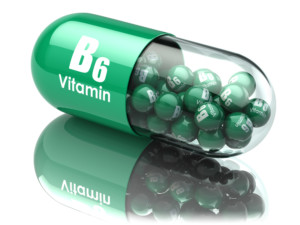The Safety of Vitamin B6
 The Linus Pauling Institute found that adverse effects have only been documented from Vitamin B6 supplements and never from food sources.
The Linus Pauling Institute found that adverse effects have only been documented from Vitamin B6 supplements and never from food sources.
Therefore, safety concerning only the supplemental form of vitamin B6 (pyridoxine, also called pyridoxine hydrochloride) is discussed here.
Although vitamin B6 is a water-soluble vitamin and is excreted in the urine, long-term supplementation with very high doses of pyridoxine (Vitamin B6) may result in painful neurological symptoms known as sensory neuropathy.
Symptoms include pain and numbness of the extremities and in severe cases, difficulty walking. Sensory neuropathy typically develops at doses of pyridoxine (Vitamin B6) in excess of 1,000 mg a day.
However, there have been a few case reports of individuals who developed sensory neuropathies at doses 500 mg of Vitamin B6 daily over a period of months.
None of the studies in which a neurological examination was performed reported evidence of sensory nerve damage at intakes below 200 mg of pyridoxine (Vitamin B6) daily.
To prevent sensory neuropathy in virtually all individuals, the Food and Nutrition Board of the Institute of Medicine set the tolerable upper intake level for pyridoxine (Vitamin B6) at 100 mg/day for adults.
For information on health problems and what can be done, see the MCVitamins Index. You can also email us and get help.
Sign up to receive the MCVitamins Newsletter!
Up-to-date info on the latest health-related news happening in the world
(available in English only)

